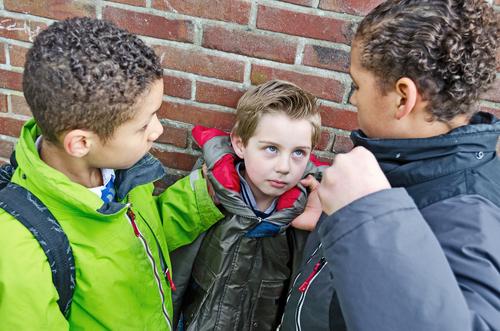This guest post is brought to you by Tara Heath. Tara is a writer and entrepreneur focused on parenting, education, and special needs.
Thanks for the share, Tara!
Keep an Eye Out and Look For The Signs: Ways Your Child Can Be Bullied
When you think of bullying, what do you picture? Do you see a big, tough boy pushing a smaller boy into a locker and threatening to punch him if he doesn’t hand over his lunch money?
Known as physical bullying, this is just one of many different types of bullying. Parents and anyone who works with children needs to be aware of the different types of bullying, and the signs of each type, in order to keep kids protected. Once you are aware of the types and signs of bullying, you can intervene and offer solutions in order to put a stop to such damaging behavior.
Physical Bullying
This is the most obvious type of bullying. It involves using physical actions in order to assert dominance. In some cases, a bully that uses physical actions will only make threats; but in many cases, these bullies actually deliver on their threats. Many children are punched, kicked and otherwise physically assaulted by these types of bullies.
The signs that physical bullying is occurring are pretty obvious. If your child comes home with a black eye, a fat lip or any other physical injury, you can question how it happened, and your child may very well reveal the source of the injury. However, your kid may make excuses, like he walked into a door, or he fell. If he is avoiding certain people, or wants to avoid a certain location or activity, there’s a good chance that his injury came from someone, not something.
Cyberbullying
In this day-and-age, the world is a very social place. Sites like Facebook, Twitter and Instagram have allowed people to connect, but they have also brought about a whole new form of bullying: Cyberbullying.
Cyberbullying refers to any harassment that takes place using technological devices. For example, a child may receive harassing posts on his Facebook page, or may receive emails that contain malicious comments.
The signs of this type of bullying are more difficult to notice. In fact, you may not be able to notice them at all. Pay attention to how your child is acting. If she is exhibiting any strange actions, or seems depressed, she may be a victim of cyberbullying. Also, keep tabs on her social interaction on the Internet and mobile devices. When you can actually see threats and harmful graphic images, you can intervene.
Verbal Bullying
Whoever said “Sticks and stones may break my bones, but names will never hurt me” was never a victim of verbal abuse. In fact, words can be just as, and even more damaging than physical harm. People who bully using words say hurtful things in order to demean their victims. They can make fun of a person’s appearance, abilities and socio-economic status. Special needs children are often victims of this type of bullying.
Because words are the weapons, it is often difficult to notice signs of verbal bullying. By paying attention to how your child acts, you may be able to pinpoint signs of this type of abuse. For example, if your child is usually upbeat and suddenly starts acting depressed or self conscious, there is a chance she may be experiencing verbal abuse.
Different types of bullying can happen anywhere and anytime. It can happen at school, during sporting events, at after school activities, on the Internet and at locations that your child frequents.
What Can You Do?
If you find out that your child is being bullied, there are several ways that you can help put a stop to the abuse.
· Talk about it: Encourage your child to take about his feelings, and ask him to think of ways that he can effectively put an end to the bullying on his own.
· Offer advice: Listen to your child and offer helpful ways to deal with the situation. Always remember to be calm and collected, and to offer the comfort that she needs.
· Make contact: You may need to contact the school or the parents of the person who is bullying your child. Do some research before you make contact so you know your information. Have a discussion about the situation and make sure to mention any laws that may be in place in your state regarding bullying.
As a parent, you want the best for your kid; and bullying is the furthest thing from the best. Being aware of the types and signs of bullying and knowing how to mediate the situation will allow you to keep your child protected.
Tara Heath is a journalist who lives in California. She has a passion for writing about education, health & wellness and parenting. She has two kids of her own and tries to keep in contact with them about these types of situations and dangers that go along with it.








{ 0 comments… add one now }